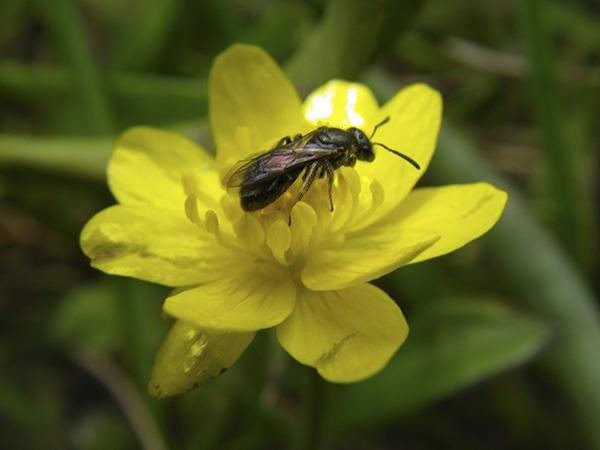By RUSSEL BARSH and MADRONA MURPHY
Special to the Sounder
The San Juan Islands are enjoying a relatively early spring green-up, flush with wildflowers such as blue camas and yellow buttercups, and all are abuzz with nectar–and pollen-loving insects. It is time to think about how colorless and tasteless our lives would be without pollinators.
Reported declines in bee populations have attracted considerable public comment and concern. Outdoor use of pesticides and other toxic compounds is certainly one factor. Bees weakened by toxic compounds are likely to forage weakly, reproduce poorly, and if exposed to parasites or pathogens, succumb more quickly than healthy bees.
Our changing climate may weaken bees further. As every gardener in the islands has probably observed, our fruit trees often bloom when cold wind and rain make it very difficult for bees to fly. Mild winters encourage plants to leaf out and flower earlier when we still have frequent rainy, stormy days. While bees are also beginning to emerge earlier in the spring, they cannot escape the physical laws governing flight muscles and wings.
But wait: what exactly do we mean when we say “bees”? And are bees the only pollinators we need to conserve in order to enjoy our flowers and fruit?
Most attention has gone to honeybees – insects native to Africa, Asia and Europe that were domesticated several thousand years ago and later introduced to North America by European farmers. What pollinators maintained our landscapes before honeybees were introduced? There are 7,500 species of bees on earth, and only seven are honeybees in the genus Apis. Hundreds of bee species can be found in San Juan County.
Over the last five years, we have surveyed pollinator-plant associations on ferry-con
nected islands as well as dozens of small, undeveloped islets. We observed thousands of insects visiting native wildflowers and domestic ornamentals.
Honeybees today represent a very small share of pollinator services in the islands, less than 10 percent. This is due in part to a relatively small number of beekeepers. Hives do not reach far. Honeybees are eclectic in their tastes but seem unable to open or find the nectar or pollen in many native wildflowers. Who does the rest of the work?
According to our surveys, native bumblebees (genus Bombus) are the most widely distributed and important pollinators in San Juan County, and their importance is greatest on smaller, isolated islands. Bumblebees fly long distances over water, work one species of flower at a time in their territories and quickly learn how to utilize unfamiliar flowers: knowledge that queens appear to pass along to their offspring.
Bumblebees are large and target flowers that are richest in pollen or nectar. Many other families of bees, such as the Halictidae (“sweat” bees) and Megachilidae (“leafcutter” bees) pick up the slack, especially in late summer when flowers are relatively scarce. We found bumblebees and other families of bees foraging peacefully together with little more than a gentle shove when bees bumped into each other on the same flower.
Unfortunately, many native bees are small, dark and easily mistaken for wasps. It is likely that many nests are destroyed due to this mistaken identity. Since our native bees nest in tiny tunnels, underground or in dead wood, they are frequently unintended victims of brush clearing and landscaping, moreover.
But even native bees are not the whole story. Our surveys found that flies provide a significant share of pollination services, and flies can be the primary pollinators of many flowering species. Included are not only the “flower” or “hover” flies (the Syrphidae) and the wonderful “bumblebee flies” (Conopidae) that disguise themselves as furry bees, but also many fly families that we often regard as pests such as the “fruit flies” (Tephritidae), “house flies” (Muscidae) and midges. When inclement weather grounds bumblebees, the flies enjoy an advantage because their lift-to-body mass ratio is greater.
How, then, can we conserve these poorly appreciated native bees and flies?
One key point is to use pesticides and herbicides sparingly, selectively and only when absolutely necessary. Apply them directly to target plants.
Never simply spray an aerosol over a garden or orchard: it will drift hundreds of feet even if you cannot see the droplets. Never spray on plants with open flowers because insects will collect contaminated pollen and eat it or feed it to their offspring.
Most of the pesticides used in the islands are pyrethroids, including pyrethrins and synthetic analogs such as permethrin and bifenthrin. Our laboratory has found pyrethroid residues in caterpillars and pollen as well as marine fish and shellfish. Neonicotinoids are unquestionably persistent and toxic to pollinators, but are simply not in widespread use in the islands. Do not condemn “neonics” and continue to spray pyrethroids.
Bee houses may be useful in some circumstances, but by far the best way to make safe homes for native bees is to leave some brushy patches, stumps and decaying logs on your property. If you make your property too neat and spiffy, you will evict most of your native pollinators!
Ironically, a frequent response to low numbers of honeybees is importing Osmids, or “mason” bees. Although we have native Osmids in the islands, the commercial variety is not native to the Northwest, and since their production and sale are not regulated, they can carry mites and infectious diseases that pass to native Osmids and other native bees.
Contact kwiaht@gmail.com for more information on recognizing and conserving native pollinator species in the San Juan Islands.



